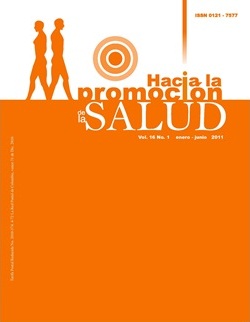Authors
Abstract
Objective: to characterize the availability of products in the school snack bars and students' food consumption during recess in Public Elementary Schools in the city of Tunja, in order to generate recommendations to promote healthy food among the school population. Materials and methods: descriptive cross-cutting study carried out in 12 snack bars with 137 public elementary school students from Tunja selected through a random stratified sampling and who complied with the inclusion criteria. The information was collected through a checking form and a consumed food during recess report format which were designed considering the common criteria found in similar investigations. The results were analyzed in a mono and multi varied manner. Results: 100% of school snack bars offered packed food products, candies, cookies and soft drinks; 91.6% offered processed fruit juice, 58.3% offered popsicles and pasties and 50% of the snack bars offered sodas. Fruits or vegetables were not offered in any of the snack bars studied. 81% of school students consumed food during recess. The food that the students bought more frequently in the school snack bars were: candies (42.2%), packed products, popsicles/ice cream in a proportion of 24.63% for each product. Conclusions: the school snack bars offered food catalogued by the authors as energetically dense with low nutritional value. Students consume this type of food during the school recess. This situation requires health promotion strategies focused on the inclusion of fruits and vegetables in the school environment and the encouragement for students to consume such products.
Keywords
References
Secretaría de Salud de Boyacá. Indicadores básicos 2009. Tunja: Secretaría de Salud de Boyacá; 2009.
Empresa Social del Estado Santiago de Tunja. Boletín Epidemiológico 2008. Tunja: Empresa Social del Estado Santiago de Tunja; 2008.
Gobernación de Boyacá: Secretaría de Salud de Boyacá. Boletín Epidemiológico de Boyacá 2007. Tunja: Secretaria de Salud de Boyacá; 2007.
Brownson RC, Haire-Joshu D, Luke DA. Shaping the context of health: a review of environmental and police approaches in the prevention in chronics diseases. Annu Rev Public Health 2006;27:341-70.
Boutayeb A, Boutayeb S. The burden of non communicable diseases in developing countries. Int J Equity Health 2005;4(1):2.
Organización Mundial de la Salud. Informe de una consulta de expertos. Dieta, nutrición y prevención de enfermedades crónicas. Ginebra: Organización Mundial de la Salud; 2003.
Prada GE, Dubeibe-Blanco LY, Herrán OF, Herrera-Anaya M. Evaluación del impacto de un ensayo comunitario sobre el consumo de frutas y verduras en Colombia. Salud Pública Mex 2007;49:11-9.
Instituto Colombiano de Bienestar Familiar. Encuesta nacional de la situación nutricional en Colombia, 2005. Bogotá: Instituto Colombiano de Bienestar Familiar; 2006.
Secretaría de Salud de Boyacá: Dirección de Salud Pública. ¿Tenemos un estilo de vida saludable los boyacenses?: Factores de Riesgo y/o protectores relacionados con enfermedades crónicas no transmisibles 2005-2007. Tunja: Secretaría de Salud de Boyacá; 2007.
Organización Mundial de la Salud, Organización de las Naciones Unidas para la Agricultura y la Alimentación – FAO. Un marco para la promoción de frutas y verduras a nivel nacional. Ginebra: Organización Mundial de la Salud; 2005.
Walton M, Pearce J, Y Day P. Examiniting the interaction between food outlets and outdoor food adversements with primary school food environments. Health Place 2009;15(3):811-8.
Organización Panamericana de la Salud. Estrategia mundial sobre régimen alimentario, actividad física y salud: Plan ejecutivo en América Latina y el Caribe 2006-2007. Washington; 2005.
Fox MK, Gordon A, Nogales R, Wilson A. Availability and consumption of competitive foods in US public schools. J Am Diet Assoc 2009;109(2 Suppl):S57-66.
School Foods Trust. A fresh look at vending in school. [on line] [citado 2009 Sep 19]. Disponible en URL: http://www.schoolfoodtrust.org.uk
Carter M, Swinburn B. Measuring the “obesogenic” food enviroment in New Zealand primary schools. Health Promot Int 2004;19(1):15-20.
Centers for Disease Control and Prevention (CDC). Competitive foods and beverages available for purchase in secondary schools - selected sites, Unites States, 2006. MMWR Morb Mortal Wkly Rep 2008;29;57(34):935-8.
Johnson DB, Bruemmer B, Lund AE, Evens CC, Mar CM. Impact of School district sugarsweetened beverage policies on student beverage exposure and consumption in middle schools. J Adolesc Health 2009;45(3 Suppl):S30-7.
Orduz DI, Rojas YC. Diseño e implementación de un programa de educación nutricional con los estudiantes de quinto grado del Instituto Técnico Gonzalo Suárez Rendón, sede El Carmen, Tunja, Boyacá. Tunja: Universidad Pedagógica y Tecnológica de Colombia; 2007.
Stokols D. Translating Social Ecological Theory into Guidelines for Community Health Promotion. Am J Health Promot 1996;10(4):282-98.
Ministerio de Salud. Resolución 008430 de 1993. Bogotá 04 de octubre de 1993.
Silva Aycaguer LC. Muestreo para la Investigación en Ciencias de la Salud. Madrid: Díaz de Santos; 1993.
McKinnon RA, Reedy J, Morrissette MA, Lytle LA, Yaroch AL. Measures of the Food Environment: A Compilation of the Literature, 1990-2007. Am J Prev Med 2009;36(4 Suppl):S124-33.
Edmunds LD, Ziebland S. Development and validation of the Day in the Life Questionnaire (DILQ) as a measure of fruit and vegetable questionnaire for 7-9 year olds. Health Educ Res 2002;17(2):211-20.
Glanz K, Lankenau B, Foerster S, Temple S, Mullis R, Schmid T. Environmental and policy approaches to cardiovascular disease prevention through nutrition: opportunities for state and local action. Health Educ Q 1995;22(4):512-27.
Molnar A, Garcia DR, Boninger F, Merrill B. Marketing of foods of minimal nutritional value to children in schools. Prev Med 2008;47(5):504-7.
Peterson G, Aguilar D, Espeche M, Mesa M, Jáuregui P, Díaz H, et al. Ácidos grasos trans en alimentos consumidos habitualmente por los jóvenes en Argentina. Arch Pediatr Urug 2006; 77(1):59-66.
Restrepo SM, Maya Gallego M. La familia y su papel en la formación de los hábitos alimentarios en el escolar: un acercamiento a la cotidianidad. Boletín de Antropología 2005;19(36);127-48.
Painter JE, Y North J. Effects of visibility and convenience on snack food consumption. J Am Diet Assoc 2003;103:166-167.
Demory-Luce D, Morales M, Nicklas T, Baranowski T, Zakeri I, Berenson G. Changes in Food Group Consumption Patterns from Childhood to Young Adulthood. J Am Diet Assoc 2004;104(11):1684-91.


 PDF (Español)
PDF (Español)
 FLIP
FLIP






















